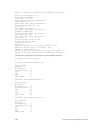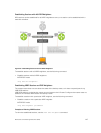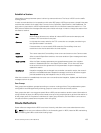
Foreign host: 2.2.2.2, Foreign port: 179
R2#
R2# show ip bgp neighbors 2.2.2.3
BGP neighbor is 2.2.2.3, remote AS 1, external link
Member of peer-group pg1 for session parameters
BGP version 4, remote router ID 12.0.0.4
BGP state ESTABLISHED, in this state for 00:05:33
...
Neighbor is using BGP neighbor mode BFD configuration
Peer active in peer-group outbound optimization
...
R2# show ip bgp neighbors 2.2.2.4
BGP neighbor is 2.2.2.4, remote AS 1, external link
Member of peer-group pg1 for session parameters
BGP version 4, remote router ID 12.0.0.4
BGP state ESTABLISHED, in this state for 00:05:33
...
Neighbor is using BGP peer-group mode BFD configuration
Peer active in peer-group outbound optimization
...
Configure BFD for VRRP
When using BFD with VRRP, the VRRP protocol registers with the BFD manager. BFD sessions are
established with all neighboring interfaces participating in VRRP. If a neighboring interface fails, the BFD
agent on the line card notifies the BFD manager, which in turn notifies the VRRP protocol that a link state
change occurred.
Configuring BFD for VRRP is a three-step process:
1. Enable BFD globally.
2. Establish VRRP BFD sessions with all VRRP-participating neighbors.
3. On the master router, establish a VRRP BFD sessions with the backup routers. Refer to Establishing
Sessions with All VRRP Neighbors.
Related Configuration Tasks
• Changing VRRP Session Parameters.
• Establishing Sessions with OSPF Neighbors.
146
Bidirectional Forwarding Detection (BFD)


















